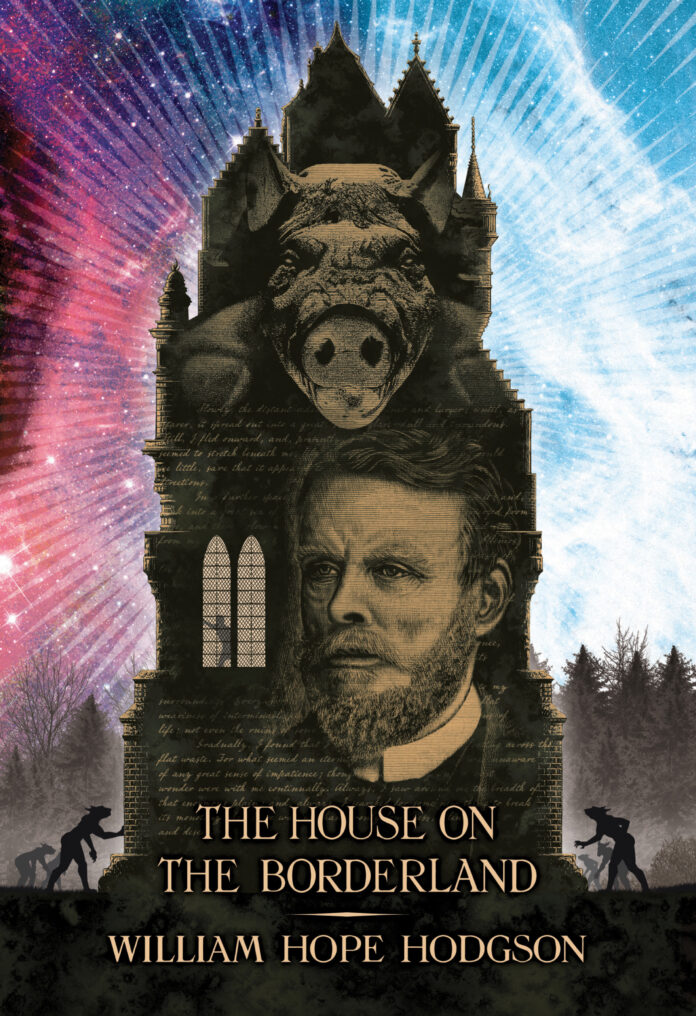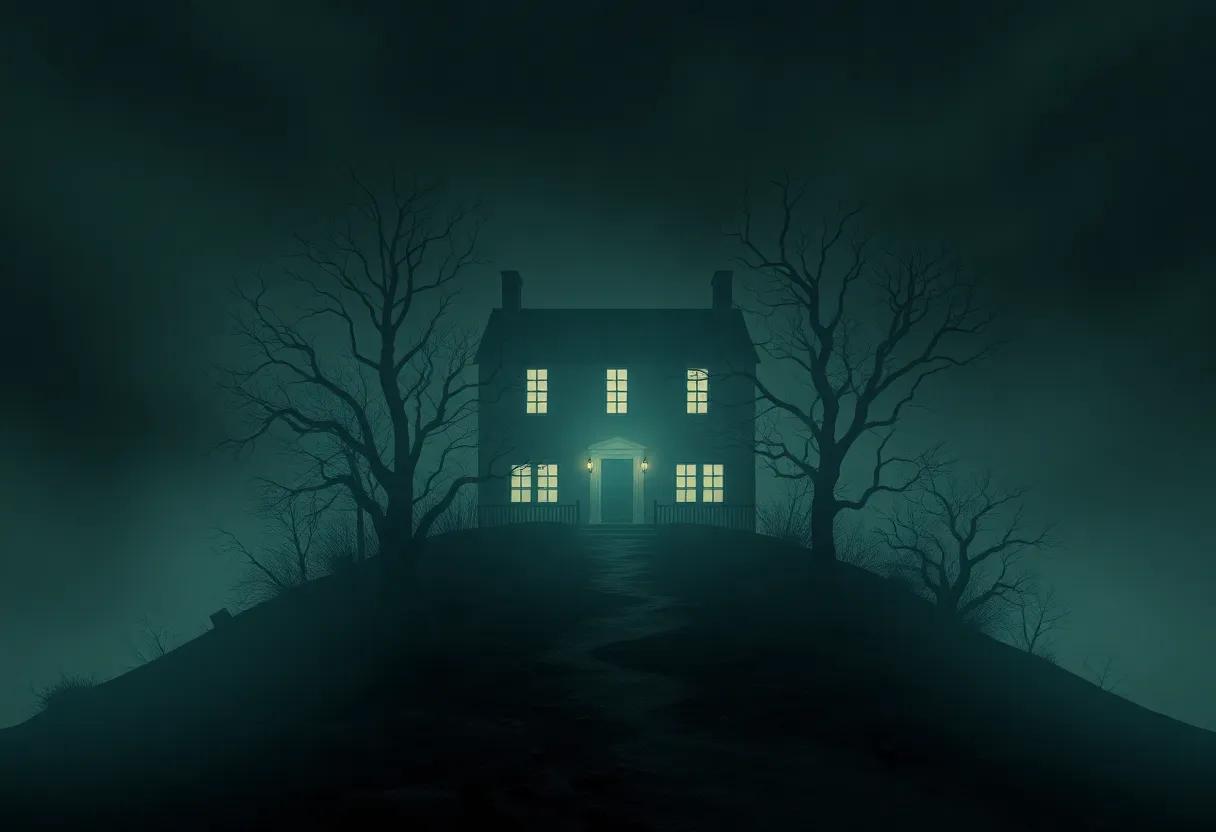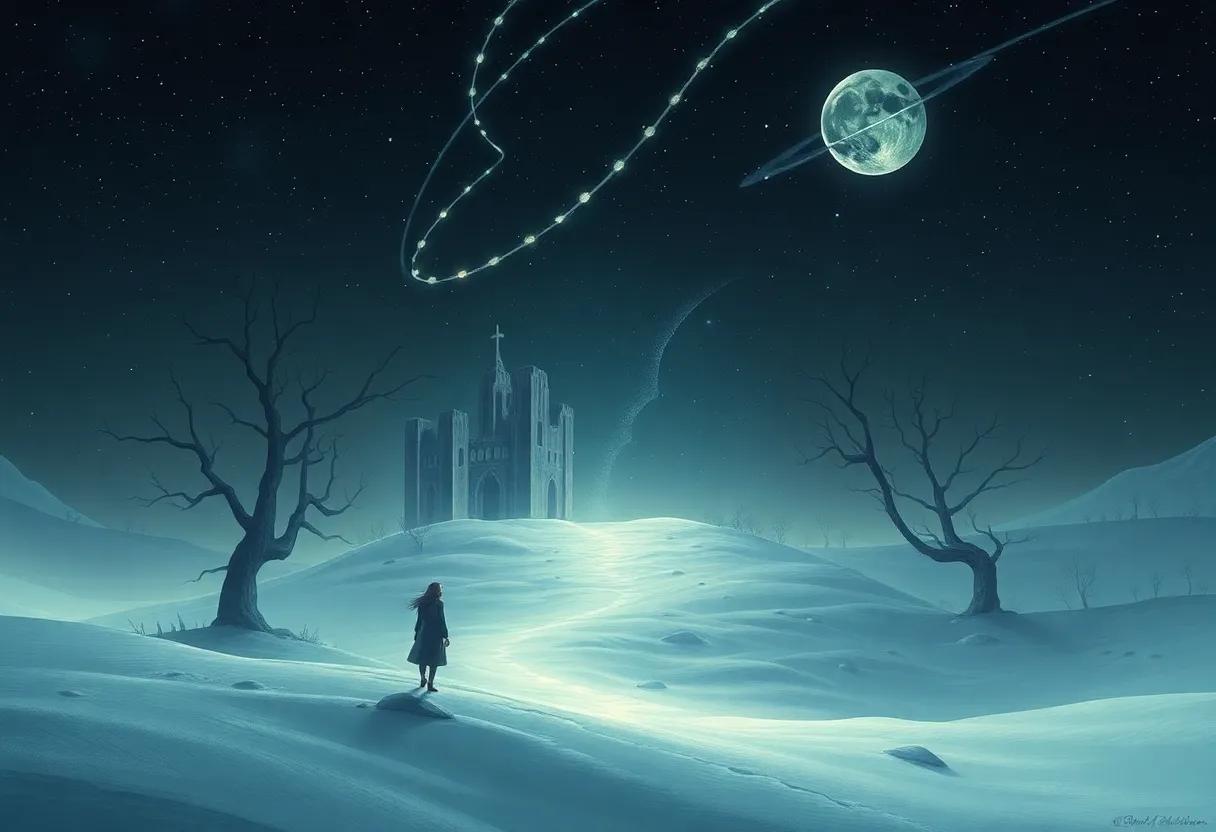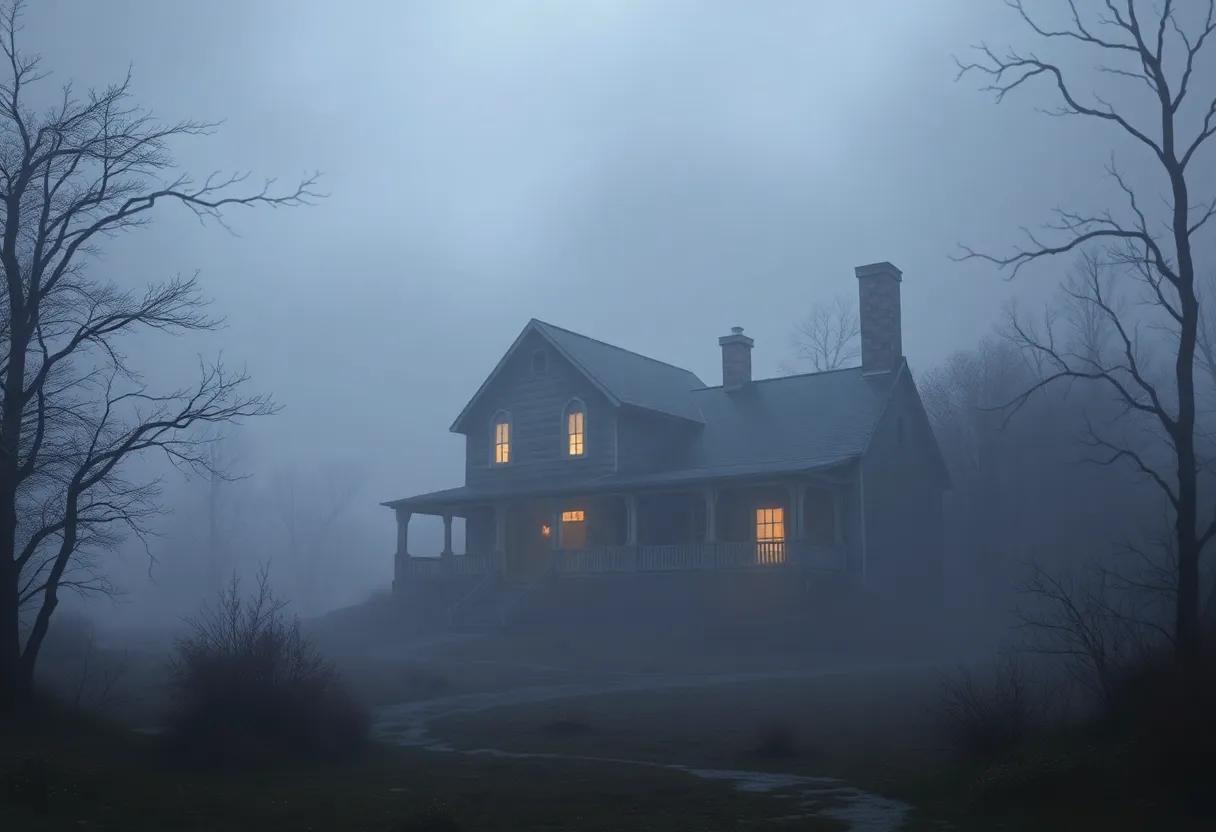Venturing into the shadowy realms where reality bends and the uncanny thrives, William Hope HodgsonS The House on the borderland stands as a seminal work in early supernatural fiction. Balancing on the precipice between cosmic horror and eerie fantasy, this novel invites readers to explore a mysterious dwelling that defies the boundaries of time and space itself.In this review, we delve into Hodgson’s atmospheric narrative and the themes that ripple beneath its haunting prose, examining how the tale continues to captivate and unsettle modern audiences while carving its unique niche in the landscape of speculative literature.
The Mysterious Atmosphere and Its Role in Building Unsettling Tension Through Ambiguous descriptions
Hodgson masterfully envelops readers in a shroud of ambiguity, where the boundaries of reality blur and certainty dissolves.The narrative thrives on vivid yet deliberately vague imagery, compelling the imagination to conjure what lies beneath the surface. Shadows shift unpredictably, sounds remain unnervingly undefined, and familiar surroundings become alien landscapes.This evocative uncertainty cultivates a creeping unease, as the reader navigates a world where every detail resists clear interpretation.
- Flickering descriptions: fleeting glimpses rather than concrete explanations
- Subtle sensory distortions: light, sound, and time warp in inexplicable ways
- Unstable settings: spaces that appear both ancient and futuristic simultaneously
these techniques serve as a psychological labyrinth, disorienting both protagonist and reader alike. The fear here springs not from overt terror but from the destabilization of understanding itself-a tension born through what is left unsaid and what can never be fully grasped. The atmosphere becomes an intangible character, its presence as oppressive and unpredictable as a gathering storm, ensuring the unsettling mood lingers long after the page is turned.
| Atmospheric Element | effect on Reader | Narrative Role |
|---|---|---|
| Opaque Visuals | Heightened curiosity mixed with disquiet | Encourages imaginative interpretation |
| Ambiguous Sounds | Instills subconscious anxiety | Signals unseen presences |
| Temporal Distortions | destabilizes sense of time and self | Reflects fragmented psyche of protagonist |
How Supernatural Elements Weave Seamlessly Into the Narrative Without Overpowering the Story’s Core
William Hope Hodgson masterfully integrates otherworldly forces into the fabric of his story, ensuring that the uncanny phenomena enhance rather than eclipse the human experience at its heart. The supernatural in The House on the Borderland emerges organically,rooted in the protagonist’s psychological journey and the eerie setting itself. Rather than relying on shock or spectacle, Hodgson’s eerie elements unfold through subtle shifts in atmosphere and perception, creating a persistent feeling of dread that slowly envelops the reader. This measured pacing allows the unkown to breathe alongside the characters’ introspection and survival struggles, resulting in a narrative harmony rather than discord.
Key techniques Hodgson employs to maintain this delicate balance include:
- Layered Descriptions: Detailed, sensory-rich depictions immerse readers in both the tangible and the spectral realms, grounding the supernatural in palpable reality.
- Ambiguous Phenomena: Supernatural events are often open to interpretation, inviting readers to question whether the bizarre occurrences are real or manifestations of the narrator’s unraveling mind.
- Interwoven Themes: Cosmic horror and existential dread mirror the protagonist’s sense of isolation, embedding the strange within universal human fears.
| Element | Effect on Narrative | Exmaple |
|---|---|---|
| Time Distortion | Diminishes linear reality | Chronological loops and leaps into the cosmic void |
| Supernatural Entities | Evokes primal fear | Menacing creatures lurking beyond perception |
| Mystical Artifacts | Anchors mystery in the physical | The diary and the manuscripts |
Analyzing the Unique Narrative Structure and Its Impact on Reader Engagement and Suspense
William Hope Hodgson employs a narrative architecture that defies customary linear storytelling, weaving layers of perspective that intensify both reader engagement and suspense. The story is principally framed through a manuscript discovered by the narrator, who shares the eerie diary entries of the Recluse. This technique creates a dual sense of distance and immediacy - readers are simultaneously observers and intimate witnesses to the unraveling mystery. The blending of reality and supernatural elements within this embedded narrative invites readers to question the reliability of the account, making suspense not just about what will happen, but what is truly happening.
The unconventional structure is further enhanced by abrupt temporal shifts and disjointed episodes that mirror the protagonist’s fracturing sanity and the otherworldly forces encroaching upon his reality. This disorientation is intentional, inviting readers to piece together fragmented clues, much like a puzzle. Key elements contributing to this immersive experience include:
- Multiple narrative layers: Manuscript within narration intensifies mystery.
- Temporal fluidity: Collapsing time frames heighten tension and uncertainty.
- Polyphonic voices: Contrasting narrators add complexity and depth.
- Fragmented storytelling: Disjointed scenes mimic psychological turmoil.
| narrative Element | Effect on reader |
|---|---|
| Embedded Manuscript | Creates layered mystery and intimacy |
| Nonlinear Timelines | Builds suspense and disorientation |
| Unreliable Narrator | invites doubt and deeper analysis |
The Influence of Cosmic Horror Themes on the Reader’s Perception of Reality and the Unknown
William Hope Hodgson’s narrative plunges readers into a labyrinth where reality itself seems malleable,forcing a confrontation with the fragile boundaries between the known and the ineffable. Through vivid depictions of unfathomable entities and eerie, otherworldly landscapes, the story subtly erodes our conventional understanding of existence, encouraging a mindset where uncertainty reigns supreme. This deliberate destabilization does more than entertain – it invites readers to reflect on humanity’s insignificance in the vast cosmic expanse, sparking a sense of existential awe and, at times, profound disquiet.
Such immersion in cosmic horror reconfigures perceptions, as the unknown transforms from a distant concept into a visceral experience. The themes within this work challenge us to ask:
- how do we reconcile with the possibility of realities beyond our comprehension?
- what does it mean for our sense of self when the universe dwarfs human experience?
- Can fear of the unknown foster both terror and a deeper appreciation for life’s mysteries?
| Cosmic Element | Effect on Reader | Perceptual Shift |
|---|---|---|
| unknowable Beings | Anxiety & Captivation | Heightened Awareness of Mystery |
| Non-Euclidean Spaces | Disorientation | Questioning Reality’s structure |
| Temporal Distortions | Unease & Curiosity | Fluidity of Time Perception |
Deconstructing the Symbolism Behind the Borderland Setting and Its Reflection of Inner Psyche
The Borderland in Hodgson’s narrative transcends mere geography, embodying a liminal space where reality blurs into the surreal and the psyche unravels its hidden depths.This ambiguous terrain acts as a mirror to the protagonist’s fragmented mind,a threshold where conscious fears and subconscious anxieties materialize into cosmic horrors. It is within this unsettling zone that time distorts, walls breathe, and dimensions overlap – all symbolic of the fragile boundaries the mind erects to hold chaos at bay. The Borderland’s shifting landscapes and alien vistas symbolize the precarious balance between order and madness,evoking the tension between the known self and the unknowable other within.
- Liminality: The border as a psychological frontier between sanity and insanity.
- Temporal Distortion: Reflects distorted memory and perception under duress.
- Cosmic Indifference: Suggests the smallness of human concerns amid incomprehensible forces.
- Isolation: Emphasizes internal alienation and existential dread.
Analyzing the Borderland through the lens of inner psyche reveals a symbolic map of human consciousness teetering on the edge of unraveling. It functions as a metaphor for the mental voyage into the abyss-where fragmented identities confront thier failings and fears. The house itself, perched within this enigmatic zone, becomes a fortress of memory and trauma, encapsulating the struggle to contain the swirling chaos outside and within. Ultimately, Hodgson’s setting is not just a backdrop but a psychological landscape, inviting readers to explore the unsettling territories that lie beyond cozy perception.
| Symbol | Psychological Interpretation | Literary Effect |
|---|---|---|
| The Borderland | Liminal space between sanity and madness | Creates tension through ambiguity |
| The house | Containment of trauma and memory | Focuses the psychological horror |
| Time Distortion | Fluidity of perception and fear | Disorients reader and protagonist alike |
| cosmic Entities | Embodiment of existential dread | Amplifies the sense of insignificance |
Character Development Through Isolation and Psychological Deterioration in a Desolate environment
In The House on the Borderland, Hodgson masterfully portrays the protagonist’s descent into madness against the backdrop of an unforgiving and isolating wilderness. The desolate environment acts as both a physical and psychological prison, amplifying his sense of vulnerability and disconnection from reality. As days blur into endless twilight, the boundaries between the tangible world and surreal visions dissolve, placing readers inside the protagonist’s fractured mind. This fusion of external desolation and internal chaos reveals how solitude can erode sanity, transforming the character’s journey into a haunting exploration of fear, despair, and ultimately, the fragile nature of human consciousness.
The narrative structure reflects this gradual unraveling through vivid imagery and unsettling shifts in perception, guiding readers through the protagonist’s psychological labyrinth. Hodgson employs key motifs that echo the themes of isolation and mental decline, including:
- Temporal distortion: Time becomes elastic, confounding the protagonist’s grasp on moments and memories.
- Cosmic insignificance: The vast, indifferent universe looms, underscoring the insignificance of human existence.
- Encroaching darkness: Shadows symbolizing encroaching madness engulf both the setting and the mind.
| Stage | Psychological Impact | Environmental Trigger |
|---|---|---|
| Initial Isolation | Anxiety and heightened awareness | Solitude in the remote house |
| Midpoint Deterioration | Hallucinations and confusion | Encroaching darkness and silence |
| Final Breakdown | Complete detachment from reality | Cosmic visions and timeless void |
Together, these elements craft a profound psychological portrait, illustrating how isolation in an alienating landscape becomes a catalyst for profound character transformation.
The Use of Vivid imagery to Craft a Visually Haunting Experience That Engages All Senses
The narrative envelops the reader in an atmosphere thick with sensory detail,transforming ordinary scenes into surreal experiences that linger long after the final page is turned. Hodgson’s prose pulses with a tactile richness; the walls of the house seem to breathe with the groans of unseen forces, while the creeping shadows evoke a chill that feels less visual and more palpable.The flickering candlelight doesn’t merely illuminate-it dances,casting bizarre silhouettes that distort reality and awaken the imagination. This meticulous orchestration of imagery doesn’t just paint a picture but invites readers to inhabit the dread, to feel the oppressive stillness in their bones, and to hear the whispered echoes of the unknown lurking just beyond perception.
What sets the sensory experience apart is its immersive synergy across all realms of sensation:
- Visual: rich descriptions of shifting landscapes and warped geometries that unsettle the eye.
- Auditory: the haunting crackle of spectral fires and the distant howls that blur the line between nightmare and reality.
- Tactile: the clammy touch of otherworldly moisture and the sudden, inexplicable temperature drops.
- Olfactory: the faint but unshakable scent of decaying wood and musty crypts.
- Kinesthetic: disorienting sensations of weightlessness and jolting shifts through space and time.
Incorporating these elements into a cohesive sensory tableau, Hodgson crafts an experience that transcends mere reading, beckoning the reader into a world where every sense signals something deeply uncanny. This mastery of vivid imagery is a haunting call not only to observe but to fully live the eerie, immersive dread that defines the novel.
Exploring the Balance Between Science Fiction and Gothic Horror Within the Novel’s Genre Hybrid
William Hope Hodgson masterfully intertwines the eerie ambiance of Gothic horror with the expansive imagination of early science fiction, creating a narrative that defies simple categorization. The novel’s setting-an isolated, decaying manor perched on the edge of reality-evokes the traditional Gothic motifs of solitude, decay, and the supernatural. Yet, Hodgson’s exploration of cosmic entities and otherworldly dimensions propels the story beyond mere spectral hauntings into the realm of speculative science fiction. This fusion generates a chilling atmosphere where the familiar tropes of ghostly dread merge with the unsettling vastness of the unknown universe.
The novel deftly balances these elements through:
- Atmospheric isolation: The protagonist’s confinement reflects Gothic sensibilities while amplifying an existential weight akin to cosmic horror.
- Temporal and Spatial dislocation: Moments of surreal science fiction disorient the reader, blurring the boundary between past, present, and other planes of existence.
- ambiguous Threats: both supernatural specters and abstract cosmic forces create layered dangers that challenge perception and sanity.
This interplay of genre conventions not only deepens the novel’s narrative complexity but invites reflection on humanity’s fragile grip on reality amid unknowable forces.
| Genre Element | Key Characteristics | Effect on story |
|---|---|---|
| Gothic Horror | Haunted setting, isolation, decay | Evokes dread and claustrophobia |
| Science Fiction | Cosmic entities, alternate dimensions | Expands scope beyond human understanding |
| Hybrid Impact | Blurring boundaries, layered threats | Creates profound existential unease |
Recommendations for Readers Interested in Classic Horror That Explores Existential and Metaphysical Dread
for readers captivated by classic horror that delves beyond mere scares into the profound realms of existential and metaphysical unease, The House on the Borderland stands as a cornerstone. Its narrative transcends temporal and spatial boundaries, inviting readers to contemplate the vastness of existence and humanity’s fragile grip on reality. Those who appreciate tales where the unknown is not just external but also a reflection of internal cosmic terror will find hodgson’s work notably resonant. Explorations of non-Euclidean spaces, time dilation, and otherworldly entities serve as metaphors for the human confrontation with the absurd and the unknowable.
To further enrich your journey into this unsettling genre, consider these seminal works and authors, each offering unique perspectives on metaphysical dread wrapped in the guise of classic horror:
- H.P. Lovecraft – His stories like The Call of Cthulhu and At the Mountains of madness pioneer cosmic horror that emphasizes mankind’s insignificance.
- Algernon Blackwood – Known for weaving nature and supernatural elements into psychologically haunting tales, such as The Willows.
- Arthur Machen - Masterful in creating an atmosphere where the mystical and the mundane intermingle, exemplified by The Great God Pan.
- Lord Dunsany – His dreamlike stories explore mythical realms that challenge human understanding and perception.
| Author | Notable Work | Core Theme |
|---|---|---|
| William Hope Hodgson | The House on the borderland | Cosmic isolation & time distortion |
| H.P. Lovecraft | The Call of Cthulhu | Cosmic insignificance & alien horrors |
| algernon blackwood | The Willows | Supernatural nature & psychological dread |
| Arthur Machen | The Great God Pan | Hidden mystical realities |
comparative Insights Into Hodgson’s Work and Its Impact on Later Horror Writers and Filmmakers
William Hope Hodgson’s work, particularly The House on the Borderland, occupies a pivotal space in the evolution of cosmic and weird horror. His unique blend of relentless atmospheric dread and sprawling cosmic terror carved pathways that later writers and filmmakers would eagerly tread.Authors such as H.P. Lovecraft and Clark ashton Smith expanded on Hodgson’s concept of incomprehensible, otherworldly forces destabilizing human reality.Notably, Hodgson’s emphasis on the unknowable and the vastness of the universe prefigured much of Lovecraft’s mythos, where humanity’s insignificance becomes an unsettling motif. His narrative techniques-especially the fusion of gothic decay with cosmic phenomena-have become a blueprint for horror creators seeking to evoke existential fear rather than mere jump scares.
Beyond literature, Hodgson’s vision has permeated horror cinema and speculative storytelling through these profound legacies:
- Atmospheric dread: The slow-building tension and oppressive isolation seen in films like The Void and The Thing echo Hodgson’s narrative style.
- Non-Euclidean spaces: Visual and narrative distortions in movies such as Event Horizon hint at Hodgson’s surreal cosmic settings.
- Interdimensional horror: Modern horror media regularly draw on Hodgson’s themes of overlapping, hostile realities that challenge human perception.
| Influence Aspect | Representative Writers/Filmmakers | Legacy on Medium |
|---|---|---|
| Cosmic Horror Concepts | H.P. Lovecraft, Ramsey Campbell | expanded mythos of unknowable forces |
| Visual Depiction of Surrealism | John Carpenter, David Cronenberg | Otherworldly and disorienting film visuals |
| Narrative Structure & Atmosphere | Caitlín R. Kiernan, Neil Marshall | Psychological isolation, slow tension build-up |
The Enduring Legacy of William Hope Hodgson as a Pioneer of Early 20th Century Supernatural Fiction
William Hope Hodgson stands as a towering figure in early 20th-century supernatural fiction, weaving narratives that delve deep into cosmic horror and the uncanny. his works, marked by an intricate blend of atmospheric dread and speculative imagination, paved the way for later masters of the genre. Hodgson’s keen ability to amalgamate the unknown with tangible reality invites readers into realms where the boundaries between the natural and supernatural blur seamlessly. His prose, both evocative and restrained, crafts a haunting ambiance that lingers long after the last page is turned.
What sets Hodgson apart is his visionary approach to storytelling, which incorporates:
- cosmic horror elements that challenge human understanding
- Exploration of isolation and existential dread
- Innovative narrative structures that evoke disorientation
- A profound connection with nature’s indifferent forces
| Aspect | hodgson’s Contribution |
|---|---|
| Atmosphere | Mysterious, oppressive, immersive |
| Characterization | Complex, frequently enough isolated protagonists |
| Themes | Cosmic insignificance, fear of the unknown |
| Narrative Style | fragmented, diary or report-based accounts |
In navigating the shadowed depths of The House on the Borderland, William Hope Hodgson crafts a realm where reality bends and the boundaries of the known dissolve into cosmic mystery. This novel, with its eerie atmosphere and haunting visions, invites readers to peer beyond the veil of the everyday and confront the unfathomable.Whether approached as a pioneering work of weird fiction or a chilling psychological odyssey, Hodgson’s tale lingers long after the final page, a quiet whisper from the edge of the unknown. For those brave enough to venture there, the journey promises both unsettling questions and a profound sense of wonder-reminding us that some mysteries are as eternal as they are inexplicable.












